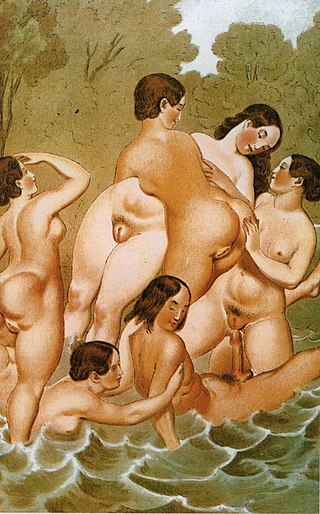
Group sex is sexual activity involving more than two people. Participants in group sex can be of any sexual orientation or gender. Any form of sexual activity can be adopted to involve more than two participants, but some forms have their own names.

Sentō (銭湯) is a type of Japanese communal bathhouse where customers pay for entrance. Traditionally these bathhouses have been quite utilitarian, with a tall barrier separating the sexes within one large room, a minimum of lined-up faucets on both sides, and a single large bath for the already washed bathers to sit in among others. Since the second half of the 20th century, these communal bathhouses have been decreasing in numbers as more and more Japanese residences now have baths. Some Japanese find social importance in going to public baths, out of the theory that physical proximity/intimacy brings emotional intimacy, which is termed skinship in pseudo-English Japanese. Others go to a sentō because they live in a small housing facility without a private bath or to enjoy bathing in a spacious room and to relax in saunas or jet baths that often accompany new or renovated sentōs.

A hammam, called a Moorish bath and a Turkish bath by Westerners, is a type of steam bath or a place of public bathing associated with the Islamic world. It is a prominent feature in the culture of the Muslim world and was inherited from the model of the Roman thermae. Muslim bathhouses or hammams were historically found across the Middle East, North Africa, al-Andalus, Central Asia, the Indian subcontinent, and in Southeastern Europe under Ottoman rule.
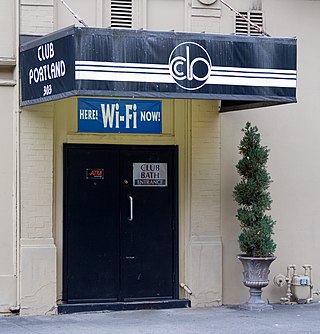
A gay bathhouse, also known as a gay sauna or a gay steambath, is a public bath targeted towards gay and bisexual men. In gay slang, a bathhouse may be called just "the baths", "the sauna", or "the tubs". Historically, they have been used for sexual activity.

Bathing is the immersion of the body, wholly or partially, in a medium, usually a liquid or heated air. It may be for personal hygiene, religious ritual, or therapeutic purposes. By analogy, especially as a recreational activity, the term is also applied to sun bathing and sea bathing.
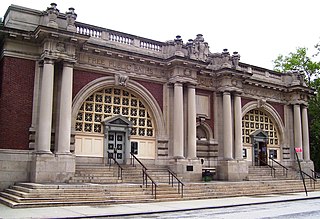
Public baths originated when most people in population centers did not have access to private bathing facilities. Though termed "public", they have often been restricted according to gender, religious affiliation, personal membership, and other criteria.

Plato's Retreat was a heterosexual swingers' club catering to couples. From 1977 until 1985 it operated in two locations in Manhattan, New York City, United States. The first was the former location of the Continental Baths, a gay bathhouse that also showcased artists who went on to great success including Bette Midler, Barry Manilow, and Melissa Manchester.

A glory hole is a hole in a wall or partition, often between public lavatory cubicles or sex video arcade booths and lounges, for people to engage in sexual activity or to observe the person on the opposite side.
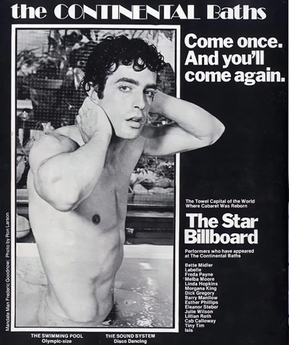
The Continental Baths was a gay bathhouse in the basement of The Ansonia Hotel in New York City, which was operated from 1968 to 1976 by Steve Ostrow. It was advertised as reminiscent of "the glory of ancient Rome".
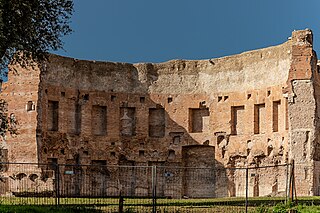
Bathing played a major part in ancient Roman culture and society. It was one of the most common daily activities and was practised across a wide variety of social classes. Though many contemporary cultures see bathing as a very private activity conducted in the home, bathing in Rome was a communal activity. While the extremely wealthy could afford bathing facilities in their homes, private baths were very uncommon, and most people bathed in the communal baths (thermae). In some ways, these resembled modern-day destination spas as there were facilities for a variety of activities from exercising to sunbathing to swimming and massage.

Gay Sex in the 70s is a 2005 American documentary film about gay sexual culture in New York City in the 1970s. The film was directed by Joseph Lovett and encompasses the twelve years of sexual freedom bookended by the Stonewall riots of 1969 and the recognition of AIDS in 1981, and features interviews with Larry Kramer, Tom Bianchi, Barton Lidice Beneš, Rodger McFarlane, and many others.
Robert Andrew "Bob" Kohler was a gay rights pioneer. Born and raised in Queens, New York, Kohler was a lifelong activist in New York City. He was at the Stonewall riots, and was a friend to many of the activists in groups like the Gay Liberation Front and Street Transvestite Action Revolutionaries.

Club Baths was a chain of gay bathhouses in the United States and Canada with particular prominence from the 1960s through the 1990s.
Bruce Mailman was an East Village entrepreneur, Off-Broadway theatre-owner and founder of The Saint and New St. Marks Baths.

The Everard Baths or Everard Spa Turkish Bathhouse was a gay bathhouse at 28 West 28th Street in New York City that operated from 1888 to 1986. The venue occupied an adaptively reused church building and was the site of a deadly fire.

The Asser Levy Recreation Center is a recreational facility in the Kips Bay neighborhood of Manhattan in New York City, composed of the Asser Levy Public Baths and Asser Levy Playground. It is bounded by East 23rd Street to the south, East 25th Street to the north, and FDR Drive to the east. Along with the former Asser Levy Place to the west, it was named after Asser Levy, one of New York City's first Jewish citizens and a strong and influential advocate for civil liberties.
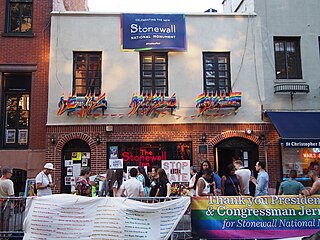
New York state, a state in the northeastern United States, has one of the largest and the most prominent LGBTQ populations in the world. Brian Silverman, the author of Frommer's New York City from $90 a Day, wrote that New York City has "one of the world's largest, loudest, and most powerful" LGBT communities", and "Gay and lesbian culture is as much a part of New York's basic identity as yellow cabs, high-rises, and Broadway theatre". LGBT travel guide Queer in the World states, "The fabulosity of Gay New York is unrivaled on Earth, and queer culture seeps into every corner of its five boroughs". LGBT Americans in New York City constitute by significant margins the largest self-identifying lesbian, gay, bisexual, and transgender communities in the United States, and the 1969 Stonewall riots in Greenwich Village are widely considered to be the genesis of the modern gay rights movement.
Finnila's Finnish Baths—a.k.a. Finnila's—was a Finnish bathhouse and a health club in San Francisco, California. It served the general public from circa 1910 to September, 2000. Finnila's was located in the Castro District of San Francisco for its first 75 years.

Club Portland, previously known as Club Baths or Continental Club Baths, was a gay bathhouse in Portland, Oregon, United States. In its place now is a hotel and a bar by McMenamins.

Man's Country was a chain of bathhouses and private clubs for gay men in Chicago and New York City.
















